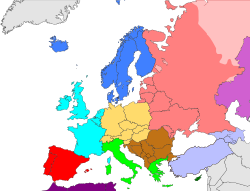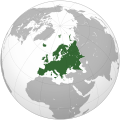ผลต่างระหว่างรุ่นของ "ยุโรปตะวันออก"
ล ย้อนการแก้ไขที่อาจเป็นการทดลอง หรือก่อกวนด้วยบอต ไม่ควรย้อน? แจ้งที่นี่ ป้ายระบุ: ย้อนด้วยมือ |
ไม่มีความย่อการแก้ไข ป้ายระบุ: เครื่องมือแก้ไขต้นฉบับปี 2560 |
||
| บรรทัด 1: | บรรทัด 1: | ||
[[File:Europe subregion map UN geoscheme.svg|thumb|upright=1.15|ภูมิภาคที่ใช้สำหรับการประมวลผลทางสถิติของ[[สำนักงานสถิติแห่งสหประชาชาติ]]<br>{{legend|#FF8080|ยุโรปตะวันออก<ref name="UN"/><ref name="un.org"/>}}{{legend|#4080FF|ยุโรปเหนือ}} |
|||
[[ไฟล์:Eastern-Europe-small.png|thumb|250 px|แผนที่ยุโรปตะวันออก]] |
|||
{{legend|#00FF00|ยุโรปใต้}} |
|||
'''ยุโรปตะวันออก''' ({{lang-en|Eastern Europe}}) มีพื้นที่อยู่ระหว่างละติจูดที่ 40 - 53 องศาเหนือ ประชากรส่วนใหญ่เป็น[[ชาวสลาฟ]] สภาพความเป็นอยู่เป็นแบบ[[ชนบท]] ประกอบไปด้วยประเทศที่เคยเป็นส่วนหนึ่งของ{{flag|สหภาพโซเวียต}}, อดีต{{flag|เช็กโกสโลวาเกีย}} (ปัจจุบันคือ{{flag|เช็กเกีย}}และ{{flag|สโลวาเกีย}}), {{flag|โปแลนด์}}, {{flag|ฮังการี}}, {{flag|โรมาเนีย}}, {{flag|บัลแกเรีย}} และอดีต{{flag|ยูโกสลาเวีย}} ประเทศส่วนใหญ่ในยุโรปตะวันออกในอดีต ปกครองด้วยระบอบ[[คอมมิวนิสต์]] แต่ในปัจจุบันนี้ได้มีการพัฒนาเป็นประชาธิปไตยบ้างแล้ว ศาสนาที่นับถือส่วนใหญ่ในภูมิภาคนี้คือ[[ศาสนาคริสต์]] ภาษาที่ใช้เป็นภาษากลุ่มโรแมนซ์และกลุ่มสลาวอนิก |
|||
{{legend|#00FFFF|ุยุโรปตะวันตก}}]] |
|||
[[File:Europe subregion map world factbook.svg|right|thumb|upright=1.15|การแบ่งภูมิภาคของยุโรปตาม[[เดอะเวิลด์แฟกต์บุ๊ก]]<br>{{legend|#FF8080|ยุโรปตะวันออกเทียบเท่ากับส่วนของยุโรปที่เคยเป็นของอดีต[[สหภาพโซเวียต]]}}{{legend|#007FFF|ยุโรปเหนือ}} |
|||
{{legend|#00FFFF|ยุโรปตะวันตก}} |
|||
{{legend|#F0DC82|ยุโรปกลาง}} |
|||
{{legend|#FF0000|ยุโรปตะวันตกเฉียงใต้}} |
|||
{{legend|#66FF00|ยุโรปใต้}} |
|||
{{legend|#D2691E|ยุโรปตะวันออกเฉียงใต้}}]] |
|||
'''ยุโรปตะวันออก''' ({{lang-en|Eastern Europe}}) เป็นภูมิภาคทางตะวันออกของ[[ทวีปยุโรป]] ไม่มีคำจำกัดความที่สอดคล้องกับพื้นที่อย่างแม่นยำและครอบคลุม ซึ่งส่วนหนึ่งเพราะศัพท์นี้มีความหมายกว้างในเชิง[[ภูมิรัฐศาสตร์]], ภูมิศาสตร์, ชาติพันธุ์, วัฒนธรรม และ[[เศรษฐกิจสังคม]] [[ประเทศรัสเซีย]]เป็นทั้งประเทศที่มี[[List of European countries by area|ขนาดใหญ่ที่สุด]]และ[[List of European countries by population|มีประชากรมากที่สุด]]ในทวีปยุโรป โดยกินพื้นที่เกือบร้อยละ 40 ของทวีป และประชากรมากกว่าร้อยละ 15 ของประชากรทั้งทวีป |
|||
รายงานจาก the Center for Educational Technologies ที่มหาวิทยาลัยเยสุอิตวีลิง มี "คำจำกัดความของยุโรปตะวันออกเกือบเท่ากับจำนวนนักวิชาการในภูมิภาคนี้"<ref name="TheBalkans">[http://www.cotf.edu/earthinfo/balkans/BKdef.html "The Balkans"] {{Webarchive|url=https://web.archive.org/web/20171210020555/http://www.cotf.edu/earthinfo/balkans/BKdef.html |date=10 December 2017 }}, ''Global Perspectives: A Remote Sensing and World Issues Site''. Wheeling Jesuit University/Center for Educational Technologies, 1999–2002.</ref> เอกสารของ[[สหประชาชาติ]]ระบุเพิ่มเติมว่า "การประเมินเอกลักษณ์เชิงพื้นที่ทุกครั้งอยู่ในกลุ่มพื้นฐานทางสังคมและ[[โครงสร้างทางวัฒนธรรม]]"<ref name="JordanEuropaRegional">{{cite web|url=http://141.74.33.52/stagn/JordanEuropaRegional/tabid/71/Default.aspx|archive-url=https://web.archive.org/web/20140404195751/http://141.74.33.52/stagn/JordanEuropaRegional/tabid/71/Default.aspx|url-status=dead|archive-date=4 April 2014|title=Jordan Europa Regional|date=4 April 2014}}</ref> |
|||
คำจำกัดความหนึ่งระบุยุโรปตะวันออกว่ามีความเป็นเอกลักษณ์ทาง[[วัฒนธรรมยุโรป|วัฒนธรรม]] โดยภูมิภาคนี้มีเอกลักษณ์หลักที่ได้รับอิทธิพลจากวัฒนธรรม[[Slavs|สลาฟ]], [[ชาวกรีก|กรีก]], [[ไบแซนไทน์]], [[Eastern Christianity|ออร์ทอดอกซ์ตะวันออก]] และ[[วัฒนธรรมของจักรวรรดิออตโตมัน|ออตโตมัน]]<ref name="UN">{{cite web|url=https://unstats.un.org/unsd/methodology/m49/#geo-regions|title=United Nations Statistics Division- Standard Country and Area Codes Classifications (M49)-Geographic Regions}}</ref><ref name="EasternEuropeHandbook">{{Cite book |last=Ramet |first=Sabrina P. |title=Eastern Europe: politics, culture, and society since 1939 |page=15 |year=1998 |publisher=[[Indiana University Press]] |url= https://books.google.com/books?id=eWmDAd6vr5sC&q=eastern+europe+definition&pg=PA15 |access-date=5 October 2011 |isbn=978-0253212566}}</ref> ส่วนอีกคำจำกัดความหนึ่งถูกสร้างขึ้นในช่วง[[สงครามเย็น]]และมักถูกใช้เป็น''[[กลุ่มตะวันออก]]'' ซึ่งมีคำอธิบายคล้ายกันของรัฐยุโรป[[คอมมิวนิสต์]]ในอดีตที่อยู่นอก[[สหภาพโซเวียต]]ว่าเป็นยุโรปตะวันออก<ref name="EasternEuropeHandbook" /> คำจำกัดความเหล่านี้ส่วนใหญ่ถูกมองว่าล้าสมัย<ref name="TheBalkans" /><ref name="science.jrank.org">{{Cite journal |url=http://science.jrank.org/pages/11016/Regions-Regionalism-Eastern-Europe-Future-Eastern-Europe.html |title=Regions, Regionalism, Eastern Europe by Steven Cassedy |publisher=New Dictionary of the History of Ideas, Charles Scribner's Sons |year=2005 |access-date=31 January 2010}}</ref><ref name="economist.com">{{cite news|url=https://www.economist.com/node/15213108|title="Eastern Europe" Wrongly labelled|newspaper=The Economist|date=7 January 2010}}</ref><ref name="CEreview">{{cite web|url=http://www.ce-review.org/99/1/hanley1.html|title=A New Journal for Central Europe|website=www.ce-review.org|access-date=31 August 2009|archive-url=https://web.archive.org/web/20171031132532/http://www.ce-review.org/99/1/hanley1.html|archive-date=31 October 2017|url-status=dead}}</ref><ref name="Aarebrot2014">{{cite book|author=Frank H. Aarebrot|title=The handbook of political change in Eastern Europe|url=https://books.google.com/books?id=2EmC92rp4joC&pg=PA1|date=14 May 2014|publisher=Edward Elgar Publishing|isbn=978-1-78195-429-4|pages=1–}}</ref> แต่บางครั้งยังคงใช้งานในเชิงสถิติ<ref name="UN" /><ref name="EuroVoc">[http://eurovoc.europa.eu/drupal/?q=node%7CEuroVoc] {{webarchive|url=https://web.archive.org/web/20150403010617/http://eurovoc.europa.eu/drupal/?q=node|date=3 April 2015}}. Eurovoc.europa.eu. Retrieved on 4 March 2015.</ref><ref name="un.org">{{Cite web|url=http://www.un.org/esa/population/publications/worldageing19502050/pdf/96annexii.pdf|title=Population Division, DESA, United Nations: World Population Ageing 1950-2050<!-- Bot generated title -->}}</ref> |
|||
==อ้างอิง== |
|||
{{Reflist}} |
|||
==อ่านเพิ่ม== |
|||
* [[Anne Applebaum|Applebaum, Anne]]. ''Iron Curtain: The Crushing of Eastern Europe, 1944–1956'' (2012) |
|||
* [[Iván T. Berend|Berend, Iván T.]] ''Decades of Crisis: Central and Eastern Europe before World War II'' (2001) |
|||
*{{cite book |last1=Connelly |first1=John |title=From Peoples Into Nations: A History of Eastern Europe |date=2020 |publisher=Princeton University Press |isbn=978-0-691-16712-1 |language=en}} |
|||
* Day, Alan J. et al. ''A Political and Economic Dictionary of Eastern Europe'' (2nd ed 2007) [https://books.google.com/books?id=dt2TXexiKTgC&newbks=0&hl=en&source=newbks_fb abstract] |
|||
* Donert, Celia, Emily Greble, and Jessica Wardhaugh. "New Scholarship on Central and Eastern Europe." ''Contemporary European History'' 26.3 (2017): 507-507. DOI: [https://doi.org/10.1017/S0960777317000224 New Scholarship on Central and Eastern Europe] |
|||
* Frankel, Benjamin. ''The Cold War 1945-1991. Vol. 2, Leaders and other important figures in the Soviet Union, Eastern Europe, China, and the Third World'' (1992), 379pp of biographies. |
|||
* Frucht, Richard, ed. ''Encyclopedia of Eastern Europe: From the Congress of Vienna to the Fall of Communism'' (2000) |
|||
* Fuchs-Schündeln, Nicola, and Matthias Schündeln. "The long-term effects of communism in Eastern Europe." ''Journal of Economic Perspectives'' 34.2 (2020): 172–91. [https://pubs.aeaweb.org/doi/pdfplus/10.1257/jep.34.2.172 online] |
|||
* Gal, Susan and Gail Kligman, ''The Politics of Gender After Socialism'' (Princeton University Press, 2000). |
|||
* Gorshkov, Boris B. "Serfdom: Eastern Europe." in ''Encyclopedia of European Social History,'' edited by Peter N. Stearns, (vol. 2: 2001), pp. 379–388. [https://link.gale.com/apps/doc/CX3460500100/GPS?u=wikipedia&sid=GPS&xid=e29075bb Online] |
|||
* [[Kristen R. Ghodsee|Ghodsee, Kristen R.]]. ''Lost in Transition: Ethnographies of Everyday Life After Communism'' (Duke University Press, 2011). |
|||
* Held, Joseph, ed. ''The Columbia History of Eastern Europe in the Twentieth Century'' (1993) |
|||
* Jeffries, Ian, and Robert Bideleux. ''The Balkans: A Post-Communist History'' (2007). |
|||
* {{Cite book|last=Jelavich|first=Barbara|author-link=Barbara Jelavich|title=History of the Balkans: Eighteenth and Nineteenth Centuries|volume=1|year=1983a|publisher=Cambridge University Press|url=https://books.google.com/books?id=qR4EeOrTm-0C|isbn=9780521274586}} |
|||
* Jelavich, Barbara. ''History of the Balkans, Vol. 1: Eighteenth and Nineteenth Centuries'' (1983) |
|||
* {{Cite book|last=Jelavich|first=Barbara|author-link=Barbara Jelavich|title=History of the Balkans: Twentieth Century|volume=2|year=1983b|publisher=Cambridge University Press|url=https://books.google.com/books?id=Hd-or3qtqrsC|isbn=9780521274593}} |
|||
* {{cite book|last=Mazower|first=Mark|title=The Balkans: A Short History|url=https://books.google.com/books?id=iWgfMZhi-x0C|year=2007|publisher=Random House Publishing Group|isbn=978-0-307-43196-7}} |
|||
* {{Cite book|last1=Myant|first1=Martin|last2=Drahokoupil|first2=Jan|title=Transition Economies: Political Economy in Russia, Eastern Europe, and Central Asia|publisher=Wiley-Blackwell|year=2010|isbn=978-0-470-59619-7}} |
|||
* Ramet, Sabrina P. ''Eastern Europe: Politics, Culture, and Society Since 1939'' (1999) |
|||
* [[Michael Roskin|Roskin, Michael G.]] ''The Rebirth of East Europe'' (4th ed. 2001); 204pp |
|||
* Schenk, Frithjof Benjamin, [http://ieg-ego.eu/en/threads/theories-and-methods/mental-maps/frithjof-benjamin-schenk-mental-maps-the-cognitive-mapping-of-the-continent-as-an-object-of-research-of-european-history?set_language=en&-C= Mental Maps: The Cognitive Mapping of the Continent as an Object of Research of European History], [http://www.ieg-ego.eu/ EGO - European History Online], Mainz: [http://www.ieg-mainz.de/likecms/index.php Institute of European History], 2013, retrieved: March 4, 2020 ([https://d-nb.info/1043735844/34 pdf]). |
|||
* Schevill, Ferdinand. ''The History of the Balkan Peninsula; From the Earliest Times to the Present Day'' (1966) |
|||
* Seton-Watson, Hugh. ''Eastern Europe Between the Wars 1918-1941'' (1945) [https://archive.org/details/in.ernet.dli.2015.183358 online] |
|||
* [[Thomas W. Simons, Jr.|Simons, Thomas W.]] ''Eastern Europe in the Postwar World'' (1991) |
|||
* [[Timothy Snyder|Snyder, Timothy]]. ''[[Bloodlands|Bloodlands: Europe Between Hitler and Stalin]]'' (2011) |
|||
* {{cite book|editor=Stanković, Vlada|title=The Balkans and the Byzantine World before and after the Captures of Constantinople, 1204 and 1453|url=https://books.google.com/books?id=avTADAAAQBAJ|year=2016|publisher=Lexington Books|isbn=978-1-4985-1326-5}} |
|||
* Stavrianos, L.S. '' The Balkans Since 1453'' (1958), major scholarly history; [https://archive.org/details/balkanssince145300lsst online free to borrow] |
|||
* Swain, Geoffrey and Nigel Swain, ''Eastern Europe Since 1945'' (3rd ed. 2003) |
|||
* Verdery, Katherine. ''What Was Socialism and What Comes Next?'' Princeton: Princeton University Press, 1996. |
|||
* {{cite book|last=Wachtel|first=Andrew Baruch|title=The Balkans in World History|url=https://archive.org/details/balkansinworldhi00wach|url-access=registration|year=2008|publisher=Oxford University Press|isbn=978-0-19-988273-1}} |
|||
* Walters, E. Garrison. ''The Other Europe: Eastern Europe to 1945'' (1988) 430pp; country-by-country coverage |
|||
* Wolchik, Sharon L. and Jane L. Curry, eds. ''Central and East European Politics: From Communism to Democracy'' (2nd ed. 2010), 432pp |
|||
*Wolff, Larry: ''Inventing Eastern Europe: The Map of Civilization on the Mind of the Enlightenment''. Stanford: Stanford University Press, 1994. {{ISBN|0-8047-2702-3}} |
|||
*{{cite book |title=Eastern Europe Unmapped: Beyond Borders and Peripheries |date=2020 |publisher=Berghahn Books |jstor=j.ctvw049zd |isbn=978-1-78533-685-0 |edition=1 }} |
|||
==แหล่งข้อมูลอื่น== |
|||
{{Commons category|Eastern Europe}} |
|||
{{Wikiquote|East/Central Europe}} |
|||
* [https://www.youtube.com/watch?v=phe8s55YA84 Interview with historian Larry Wolff on "Inventing Eastern Europe"] |
|||
* [https://web.archive.org/web/20110805130513/http://www.databasece.com/en/macro-summary Eastern Europe Economic Data] |
|||
* [http://www.emerging-europe.com Emerging Europe - A new narrative for the region] |
|||
{{ยุโรป}} |
|||
{{ดินแดน}} |
{{ดินแดน}} |
||
{{Authority control}} |
|||
{{coord|50|N|30|E|source:wikidata|display=title}} |
|||
[[หมวดหมู่:ยุโรปตะวันออก| ]] |
[[หมวดหมู่:ยุโรปตะวันออก| ]] |
||
รุ่นแก้ไขเมื่อ 12:08, 24 มกราคม 2565


ยุโรปตะวันออก (อังกฤษ: Eastern Europe) เป็นภูมิภาคทางตะวันออกของทวีปยุโรป ไม่มีคำจำกัดความที่สอดคล้องกับพื้นที่อย่างแม่นยำและครอบคลุม ซึ่งส่วนหนึ่งเพราะศัพท์นี้มีความหมายกว้างในเชิงภูมิรัฐศาสตร์, ภูมิศาสตร์, ชาติพันธุ์, วัฒนธรรม และเศรษฐกิจสังคม ประเทศรัสเซียเป็นทั้งประเทศที่มีขนาดใหญ่ที่สุดและมีประชากรมากที่สุดในทวีปยุโรป โดยกินพื้นที่เกือบร้อยละ 40 ของทวีป และประชากรมากกว่าร้อยละ 15 ของประชากรทั้งทวีป
รายงานจาก the Center for Educational Technologies ที่มหาวิทยาลัยเยสุอิตวีลิง มี "คำจำกัดความของยุโรปตะวันออกเกือบเท่ากับจำนวนนักวิชาการในภูมิภาคนี้"[3] เอกสารของสหประชาชาติระบุเพิ่มเติมว่า "การประเมินเอกลักษณ์เชิงพื้นที่ทุกครั้งอยู่ในกลุ่มพื้นฐานทางสังคมและโครงสร้างทางวัฒนธรรม"[4]
คำจำกัดความหนึ่งระบุยุโรปตะวันออกว่ามีความเป็นเอกลักษณ์ทางวัฒนธรรม โดยภูมิภาคนี้มีเอกลักษณ์หลักที่ได้รับอิทธิพลจากวัฒนธรรมสลาฟ, กรีก, ไบแซนไทน์, ออร์ทอดอกซ์ตะวันออก และออตโตมัน[1][5] ส่วนอีกคำจำกัดความหนึ่งถูกสร้างขึ้นในช่วงสงครามเย็นและมักถูกใช้เป็นกลุ่มตะวันออก ซึ่งมีคำอธิบายคล้ายกันของรัฐยุโรปคอมมิวนิสต์ในอดีตที่อยู่นอกสหภาพโซเวียตว่าเป็นยุโรปตะวันออก[5] คำจำกัดความเหล่านี้ส่วนใหญ่ถูกมองว่าล้าสมัย[3][6][7][8][9] แต่บางครั้งยังคงใช้งานในเชิงสถิติ[1][10][2]
อ้างอิง
- ↑ 1.0 1.1 1.2 "United Nations Statistics Division- Standard Country and Area Codes Classifications (M49)-Geographic Regions".
- ↑ 2.0 2.1 "Population Division, DESA, United Nations: World Population Ageing 1950-2050" (PDF).
- ↑ 3.0 3.1 "The Balkans" เก็บถาวร 10 ธันวาคม 2017 ที่ เวย์แบ็กแมชชีน, Global Perspectives: A Remote Sensing and World Issues Site. Wheeling Jesuit University/Center for Educational Technologies, 1999–2002.
- ↑ "Jordan Europa Regional". 4 April 2014. คลังข้อมูลเก่าเก็บจากแหล่งเดิมเมื่อ 4 April 2014.
- ↑ 5.0 5.1 Ramet, Sabrina P. (1998). Eastern Europe: politics, culture, and society since 1939. Indiana University Press. p. 15. ISBN 978-0253212566. สืบค้นเมื่อ 5 October 2011.
- ↑ "Regions, Regionalism, Eastern Europe by Steven Cassedy". New Dictionary of the History of Ideas, Charles Scribner's Sons. 2005. สืบค้นเมื่อ 31 January 2010.
{{cite journal}}: Cite journal ต้องการ|journal=(help) - ↑ ""Eastern Europe" Wrongly labelled". The Economist. 7 January 2010.
- ↑ "A New Journal for Central Europe". www.ce-review.org. คลังข้อมูลเก่าเก็บจากแหล่งเดิมเมื่อ 31 October 2017. สืบค้นเมื่อ 31 August 2009.
- ↑ Frank H. Aarebrot (14 May 2014). The handbook of political change in Eastern Europe. Edward Elgar Publishing. pp. 1–. ISBN 978-1-78195-429-4.
- ↑ [1] เก็บถาวร 3 เมษายน 2015 ที่ เวย์แบ็กแมชชีน. Eurovoc.europa.eu. Retrieved on 4 March 2015.
อ่านเพิ่ม
- Applebaum, Anne. Iron Curtain: The Crushing of Eastern Europe, 1944–1956 (2012)
- Berend, Iván T. Decades of Crisis: Central and Eastern Europe before World War II (2001)
- Connelly, John (2020). From Peoples Into Nations: A History of Eastern Europe (ภาษาอังกฤษ). Princeton University Press. ISBN 978-0-691-16712-1.
- Day, Alan J. et al. A Political and Economic Dictionary of Eastern Europe (2nd ed 2007) abstract
- Donert, Celia, Emily Greble, and Jessica Wardhaugh. "New Scholarship on Central and Eastern Europe." Contemporary European History 26.3 (2017): 507-507. DOI: New Scholarship on Central and Eastern Europe
- Frankel, Benjamin. The Cold War 1945-1991. Vol. 2, Leaders and other important figures in the Soviet Union, Eastern Europe, China, and the Third World (1992), 379pp of biographies.
- Frucht, Richard, ed. Encyclopedia of Eastern Europe: From the Congress of Vienna to the Fall of Communism (2000)
- Fuchs-Schündeln, Nicola, and Matthias Schündeln. "The long-term effects of communism in Eastern Europe." Journal of Economic Perspectives 34.2 (2020): 172–91. online
- Gal, Susan and Gail Kligman, The Politics of Gender After Socialism (Princeton University Press, 2000).
- Gorshkov, Boris B. "Serfdom: Eastern Europe." in Encyclopedia of European Social History, edited by Peter N. Stearns, (vol. 2: 2001), pp. 379–388. Online
- Ghodsee, Kristen R.. Lost in Transition: Ethnographies of Everyday Life After Communism (Duke University Press, 2011).
- Held, Joseph, ed. The Columbia History of Eastern Europe in the Twentieth Century (1993)
- Jeffries, Ian, and Robert Bideleux. The Balkans: A Post-Communist History (2007).
- Jelavich, Barbara (1983a). History of the Balkans: Eighteenth and Nineteenth Centuries. Vol. 1. Cambridge University Press. ISBN 9780521274586.
- Jelavich, Barbara. History of the Balkans, Vol. 1: Eighteenth and Nineteenth Centuries (1983)
- Jelavich, Barbara (1983b). History of the Balkans: Twentieth Century. Vol. 2. Cambridge University Press. ISBN 9780521274593.
- Mazower, Mark (2007). The Balkans: A Short History. Random House Publishing Group. ISBN 978-0-307-43196-7.
- Myant, Martin; Drahokoupil, Jan (2010). Transition Economies: Political Economy in Russia, Eastern Europe, and Central Asia. Wiley-Blackwell. ISBN 978-0-470-59619-7.
- Ramet, Sabrina P. Eastern Europe: Politics, Culture, and Society Since 1939 (1999)
- Roskin, Michael G. The Rebirth of East Europe (4th ed. 2001); 204pp
- Schenk, Frithjof Benjamin, Mental Maps: The Cognitive Mapping of the Continent as an Object of Research of European History, EGO - European History Online, Mainz: Institute of European History, 2013, retrieved: March 4, 2020 (pdf).
- Schevill, Ferdinand. The History of the Balkan Peninsula; From the Earliest Times to the Present Day (1966)
- Seton-Watson, Hugh. Eastern Europe Between the Wars 1918-1941 (1945) online
- Simons, Thomas W. Eastern Europe in the Postwar World (1991)
- Snyder, Timothy. Bloodlands: Europe Between Hitler and Stalin (2011)
- Stanković, Vlada, บ.ก. (2016). The Balkans and the Byzantine World before and after the Captures of Constantinople, 1204 and 1453. Lexington Books. ISBN 978-1-4985-1326-5.
- Stavrianos, L.S. The Balkans Since 1453 (1958), major scholarly history; online free to borrow
- Swain, Geoffrey and Nigel Swain, Eastern Europe Since 1945 (3rd ed. 2003)
- Verdery, Katherine. What Was Socialism and What Comes Next? Princeton: Princeton University Press, 1996.
- Wachtel, Andrew Baruch (2008). The Balkans in World History. Oxford University Press. ISBN 978-0-19-988273-1.
- Walters, E. Garrison. The Other Europe: Eastern Europe to 1945 (1988) 430pp; country-by-country coverage
- Wolchik, Sharon L. and Jane L. Curry, eds. Central and East European Politics: From Communism to Democracy (2nd ed. 2010), 432pp
- Wolff, Larry: Inventing Eastern Europe: The Map of Civilization on the Mind of the Enlightenment. Stanford: Stanford University Press, 1994. ISBN 0-8047-2702-3
- Eastern Europe Unmapped: Beyond Borders and Peripheries (1 ed.). Berghahn Books. 2020. ISBN 978-1-78533-685-0. JSTOR j.ctvw049zd.

